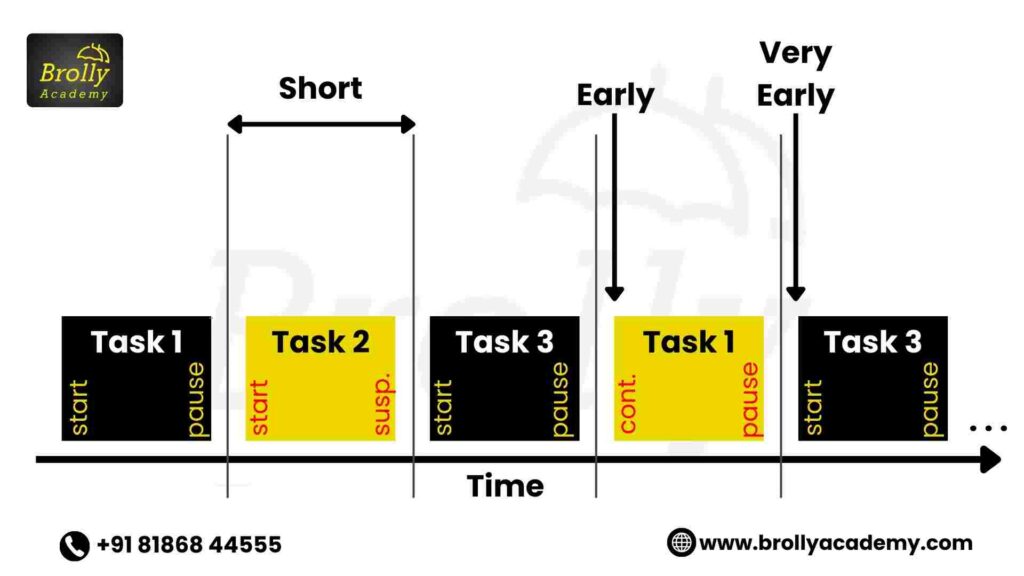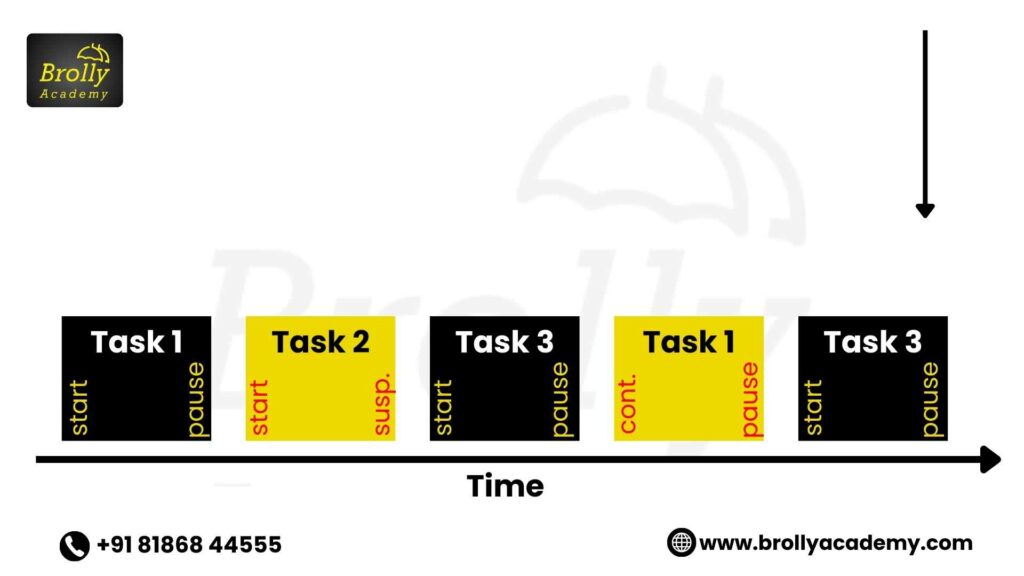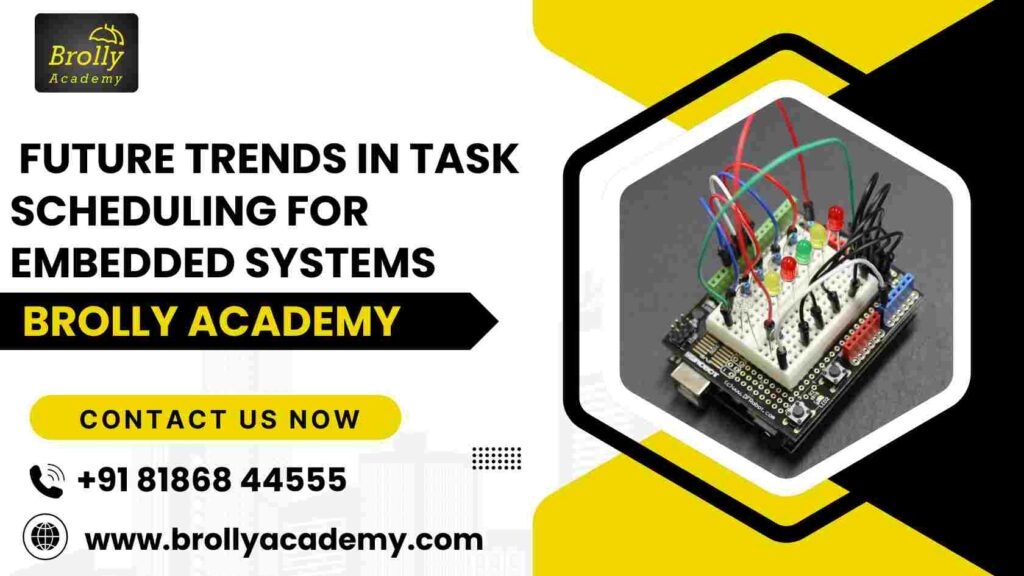Task Scheduling in Embedded Systems

1. Introduction to Task Scheduling in Embedded Systems
- Task scheduling is a crucial process in embedded systems, where multiple tasks or operations need to be managed and executed in a timely, efficient manner.
- Embedded systems are specialized computing systems designed to perform dedicated functions within larger devices, such as automotive control units, medical devices, industrial automation systems, and consumer electronics.
- Each of these systems has specific requirements for performance, reliability, and resource optimization, making effective task scheduling essential.
- In an embedded environment, task scheduling involves determining the order and timing with which tasks (processes or threads) are executed by the system’s processor(s).
- Since many embedded systems operate under constraints such as limited processing power, memory, and energy consumption, task scheduling must carefully balance these resources to maintain functionality, responsiveness, and power efficiency.
Additionally, some embedded systems require real-time scheduling to ensure that critical tasks are completed within specified time limits, which is common in systems handling real-world physical processes like sensor data acquisition or motor control.

2. Types of Task Scheduling Techniques
- Each task runs until it finishes or decides to stop and lets another task run.
- Simple and easy to use, but if one task doesn’t yield control, other tasks can be delayed.
- Works well in small systems without strict timing needs.
- The system can interrupt (or “preempt”) tasks if a more important task comes along.
- Ensures that high-priority tasks can run immediately.
- Ideal for systems where certain tasks must run on time, like real-time systems.
- Each task gets a fixed amount of time, then the next task takes its turn.
- This approach gives each task fair access to the processor.
- It is good for systems where all tasks are equally important, but not for time-sensitive tasks.
- Tasks that need to run more frequently are given higher priority.
- It is useful for tasks that repeat at set intervals (like every second or millisecond).
- Great for predictable systems but needs careful setup to avoid missed deadlines.
- The task with the closest (or “earliest”) deadline gets priority.
- Helps make sure tasks finish on time, useful in systems with flexible timing.
- Works well when deadlines are important but not critical.
6. Static vs. Dynamic Scheduling
- Static Scheduling: Scheduling is set before the system runs, making it very predictable.
- Dynamic Scheduling: Decisions are made during operation, allowing flexibility for changes.
- Static scheduling is best for systems with fixed tasks; dynamic scheduling is better for changing tasks.
- A mix of static and dynamic scheduling methods.
- Critical tasks might use static scheduling for predictability, while other tasks use dynamic scheduling.
- Useful for complex systems that need both fixed and flexible timing.
Each of these techniques helps manage tasks differently, depending on the system’s needs, priorities, and timing requirements.
if you want to learn more about Task Scheduling in Embedded Systems from our Expert Trainer at Brolly Academy Enorll Now or What’s App we will reach you no time
3. Importance of Task Scheduling in Embedded Systems
- Task scheduling is essential in embedded systems because it helps ensure that each task or function is completed on time, especially in devices where timing and order are critical.
- Many embedded systems, like medical devices, car control units, and industrial machines, need to perform specific actions within set time frames to work correctly and safely.
- Without proper scheduling, tasks could either take too long or interfere with each other, which can lead to malfunctions or delays.
- For example, in a car’s braking system, tasks that handle sensor readings and control the brakes need to happen at precise times.
- If the scheduling isn’t managed well, these actions might be delayed, which could cause unsafe conditions.
- Good scheduling also helps the system use its limited resources, such as memory and processing power, efficiently.
- Since embedded systems often run on smaller, simpler hardware, making sure each task is properly timed and prioritized helps avoid overloading the system and keeps everything running smoothly.
- This is especially important in systems that run for long periods on limited battery power, where task scheduling in Embedded systems helps conserve energy.
In short, task scheduling in embedded systems runs on time, safely, and efficiently.
If you’re interested in learning about Task Scheduling in Embedded Systems, join Brolly Academy‘s expert-led training program. Enroll now or WhatsApp us for quick assistance! 📲
4. Real-Time Task Scheduling Concepts
- In hard real-time systems, tasks must be completed within a strict deadline.
- Missing a deadline can cause serious problems or even system failure.
- Example: Airbag deployment in cars. If the airbag does not deploy on time during a crash, it fails to protect the passenger.
2. Soft Real-Time Systems
- In soft real-time systems, meeting the deadline is important, but occasional delays are acceptable and won’t cause critical failures.
- Delays may reduce performance but won’t lead to dangerous outcomes.
- Example: Video streaming. If a frame is slightly delayed, it might affect the quality, but the video will still play.
5. Fixed-Priority vs. Dynamic Scheduling
- In fixed-priority scheduling, each task is given a specific priority level that doesn’t change.
- Tasks with higher priority will always be chosen over lower-priority tasks.
- This method is straightforward and predictable, making it useful in systems with critical tasks that must run reliably and consistently.
- Example: In a medical device, monitoring a patient’s heart rate might have a higher priority than displaying data on a screen.

- With dynamic scheduling, task priorities can change based on the system’s current needs or conditions.
- This means that a task’s priority can be adjusted in real-time to handle tasks more flexibly, depending on how soon they need to be completed.
- Dynamic scheduling is more adaptable, so it’s often used in systems where tasks have varying levels of importance or deadlines.
- Example: In a video game, processing player controls might become a high priority during certain actions, while at other times, background updates take priority.
6. Common Scheduling Algorithms in Embedded Systems
1. First-Come, First-Served (FCFS)
- In this method, tasks are executed in the order they arrive, just like waiting in a queue. The first task to enter the queue is the first to be processed. While simple and easy to implement, it can cause delays if long tasks are in the queue before shorter ones.
- Round-robin scheduling allocates a fixed time slice for each task to run. When a task’s time slice expires, the next task gets a turn, ensuring each task gets an equal opportunity to execute. This method is fair and prevents any task from monopolizing the processor, but it may not be suitable for time-critical tasks.
RMS assigns higher priority to tasks that need to be executed more frequently. This ensures that time-critical tasks are given preference, making it ideal for real-time systems where timing is crucial. However, it assumes tasks are independent and have predictable periodic behavior.
In EDF, tasks are prioritized based on their deadlines, with the task that has the nearest deadline being executed first. This method ensures that tasks are completed on time, making it highly efficient for soft real-time systems.
Priority-based scheduling assigns a priority level to each task, and the system always runs the highest-priority task. This approach ensures critical tasks are completed first, but it requires careful management to avoid lower-priority tasks from being indefinitely delayed (known as “starvation”).
Learn more about Task Scheduling in Embedded Systems from our expert trainer at Brolly Academy. Enroll now or WhatsApp us, and we’ll connect with you promptly
7. Factors Affecting Task Scheduling in Embedded Systems
- Task Priorities: Some tasks are more important than others. The system gives higher priority to important tasks to make sure they are completed first.
- For example, tasks that control safety features in a car are more important than tasks that update the display.
- Deadline Constraints: Some tasks must be finished by a certain time. If a task doesn’t finish on time, it can cause problems. The system needs to make sure these tasks are done before their deadlines.
- Task Periodicity: Some tasks need to run at regular intervals, like checking sensors every second. The system must be able to handle these tasks regularly and on time.
- Task Dependencies: Some tasks can’t start until another task is finished. For example, a task that uses data from a sensor must wait for the sensor reading task to finish first.
- System Resources: Embedded systems often have limited memory and processing power. The system needs to manage resources wisely, making sure that tasks don’t use too much memory or processing power.
- Interrupt Handling: Sometimes, urgent events can interrupt normal tasks. The system needs to handle these events quickly without delaying important tasks.
- Energy Constraints: Many embedded systems run on battery power. The system needs to schedule tasks in a way that saves energy, so the device can run longer without charging.
8. Challenges in Task Scheduling in Embedded Systems
1. Limited Resources
- Embedded systems often have limited resources, such as processing power, memory, and storage. This makes it difficult to handle multiple tasks simultaneously, especially in systems that need to perform complex operations.
- Challenge: Efficiently managing and allocating resources to tasks without overloading the system is crucial.
2. Real-Time Constraints
- Many embedded systems are real-time systems, where tasks must be completed within specific time limits. Missing a deadline can result in system failure, such as a safety-critical system not responding in time.
- Challenge: Ensuring that time-critical tasks are completed within their deadlines while other less-critical tasks do not cause delays.
3. Task Dependencies
- Some tasks depend on the completion of other tasks before they can start. These dependencies create a challenge when scheduling, as the system must ensure that dependent tasks are executed in the correct order.
- Challenge: Managing task dependencies without causing delays or bottlenecks can be difficult, especially in complex systems with many interrelated tasks.
4. Interrupt Handling
- Interrupts are events that require immediate attention and can stop normal task execution. Interrupts must be handled quickly, but excessive interrupt handling can affect the performance of regular tasks.
- Challenge: Balancing interrupt handling with task execution is critical to ensure that interrupts do not disrupt important tasks.
5. Energy Efficiency
- Many embedded systems, like mobile or IoT devices, are battery-powered. Scheduling tasks to minimize energy consumption while maintaining performance is a significant challenge.
- Challenge: Ensuring the system uses energy-efficient scheduling techniques, like powering down components during idle times, without sacrificing performance.
6. Dynamic Nature of Tasks
- Some embedded systems deal with tasks that change dynamically, such as varying task execution time or different input conditions. This makes it difficult to plan and allocate resources for each task in advance.
- Challenge: Adapting the scheduling algorithm to handle tasks that change in nature or frequency, ensuring that all tasks are executed properly despite the dynamic environment.
7. Hard vs. Soft Real-Time Systems
- In hard real-time systems, missing a deadline can result in catastrophic failure (e.g., medical devices or automotive safety systems). In soft real-time systems, missing deadlines may degrade performance but won’t cause failure (e.g., multimedia streaming).
- Challenge: Choosing the right scheduling strategy depending on whether the system is hard or soft real-time, ensuring that critical systems always meet deadlines.
8. Task Prioritization
- Determining the priority of tasks can be difficult, especially when tasks are of equal importance or when priorities change dynamically based on system state or external factors.
- Challenge: Deciding which task should be given priority, especially when multiple tasks are competing for the same resources.
9. Best Practices for Task Scheduling in Embedded Systems
1. Prioritize Critical Tasks
- Always prioritize tasks based on their importance. Critical tasks, such as those related to safety or core functionality, should be given the highest priority to ensure they are executed on time.
- Best Practice: Use priority-based scheduling to assign higher priority to time-sensitive tasks.
2. Optimize Resource Usage
- Embedded systems often have limited resources, so it’s crucial to optimize how resources like processing power, memory, and storage are used. Efficient task scheduling ensures that resources are used in the most effective way possible.
- Best Practice: Implement algorithms that minimize resource wastage, such as using task grouping or merging smaller tasks to reduce overhead.
3. Use Time-Partitioning for Complex Tasks
- If the system handles complex tasks, use time partitioning. This means dividing time into small slots and dedicating each slot to specific tasks, ensuring that tasks do not interfere with each other.
- Best Practice: Set up fixed time slices for each task to ensure fair distribution of CPU time.
4. Handle Interrupts Efficiently
- Interrupts need to be handled quickly and appropriately to avoid delays in the execution of other tasks. However, excessive interrupt handling can disrupt the overall task scheduling.
- Best Practice: Limit the time spent handling interrupts, and prioritize interrupts based on their urgency to avoid overwhelming the system.
5. Monitor Task Performance
- Continuously monitor the performance of tasks to ensure that they are completing as expected and within the required time constraints. This helps in detecting performance degradation early and adjusting schedules accordingly.
- Best Practice: Use tools to track task performance and identify potential delays, allowing adjustments in the scheduling process.
6. Use Real-Time Operating Systems (RTOS)
- An RTOS is designed to manage tasks with strict timing requirements. Using an RTOS can help automate and manage task scheduling efficiently, especially in real-time systems.
- Best Practice: Implement an RTOS that supports priority-based scheduling, real-time monitoring, and efficient resource management.
7. Energy-Efficient Scheduling
- Many embedded systems are battery-powered, so it’s essential to minimize energy consumption while ensuring tasks are completed on time.
- Best Practice: Schedule power-intensive tasks during periods of low activity or use low-power modes when tasks are idle to conserve energy.
8. Task Grouping and Preemption
- Group related tasks together to reduce the time needed to switch between tasks. Preemptive scheduling allows higher-priority tasks to interrupt lower-priority ones when necessary.
- Best Practice: Use preemptive scheduling to ensure critical tasks are never delayed by lower-priority ones, but also group similar tasks to reduce context-switching overhead.
9. Test and Simulate Schedules
- Before implementing task schedules in a live system, it is important to test and simulate the schedules under different conditions. This helps identify any potential issues with the scheduling algorithm.
- Best Practice: Use simulation tools to test different task scheduling scenarios, making adjustments to optimize performance and reliability.
10. Adapt Scheduling to System Changes
- Embedded systems can change over time, whether due to hardware upgrades, changes in task requirements, or shifting priorities. It is important to adapt the scheduling system to these changes.
- Best Practice: Regularly review and adjust task scheduling strategies as the system evolves to maintain efficiency and meet new requirements.
10. Future Trends in Task Scheduling for Embedded Systems

- AI and Machine Learning: AI and machine learning are increasingly being used to improve task scheduling in embedded systems. These technologies can analyze past task performance to automatically adjust scheduling decisions for better efficiency and resource utilization.
- Edge Computing: Edge computing will enable embedded devices to process data locally instead of relying heavily on cloud computing. This reduces latency by processing tasks closer to the source of the data, improving the system’s responsiveness and efficiency.
- Energy-Efficient Scheduling: As embedded systems are often battery-powered, optimizing energy use is crucial. Future task scheduling algorithms will focus on reducing power consumption by scheduling tasks more intelligently.
- Real-Time Adjustments: Embedded systems will increasingly be able to make real-time adjustments to task scheduling based on changing system conditions.
- Cloud and IoT Integration: With the rise of IoT devices, embedded systems will need to work seamlessly with cloud computing. Task scheduling will expand beyond local devices to include cloud resources, allowing tasks to be offloaded or shared between local devices and the cloud for better scalability.
- Multi-Core Processing: Multi-core processors are becoming more common in embedded systems, allowing multiple tasks to be executed simultaneously.
- Fault Tolerance: As embedded systems are used in more critical applications, ensuring reliability is key. Task scheduling will incorporate fault tolerance mechanisms that allow systems to continue processing tasks even if a part of the system fails.
Conclusion
Additionally, the integration of the cloud and the Internet of Things, multi-core processing, and fault tolerance will further enhance the capabilities of embedded systems, making them more intelligent, responsive, and scalable. The continuous evolution of task scheduling methods will allow embedded systems to handle increasingly complex tasks while maintaining high efficiency, reliability, and low power consumption.
If you want to explore Task Scheduling in Embedded Systems with insights from our experienced trainer at Brolly Academy, enroll now or WhatsApp us for prompt assistance. Let’s get started!
FAQ’s
Task Scheduling in Embedded Systems
1. What is task scheduling in embedded systems?
2. Why is task scheduling important in embedded systems?
3. What are real-time task scheduling systems?
Real-time task scheduling systems ensure that tasks are executed within a strict time frame, meeting deadlines without delay. These systems are essential for applications that require immediate responses, such as in automotive or medical devices.
4. What are the different types of task scheduling algorithms?
Common types of task scheduling algorithms include:
- Round Robin: Each task gets an equal share of CPU time.
- Priority Scheduling: Tasks are assigned priorities, and higher-priority tasks are executed first.
- Rate Monotonic: Tasks with shorter deadlines are prioritized. Each has its advantages depending on the specific requirements of the system.
5. What is the role of multi-core processing in task scheduling?
Multi-core processing allows multiple tasks to be processed simultaneously, improving system performance. Task scheduling algorithms help distribute tasks across different cores to maximize efficiency and speed.
